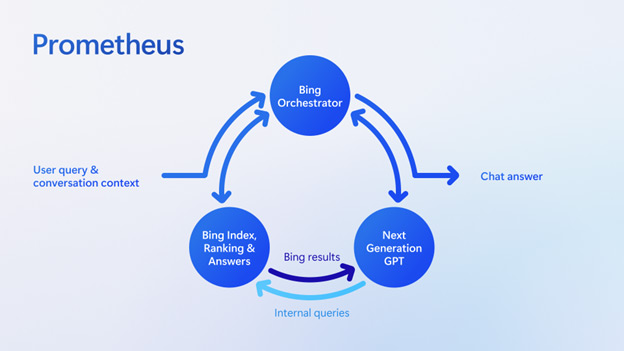Microsoft Bing Blogs published new information about how the new AI-integrated search works, including details of a technology called Bing Orchestrator that works like a coordinator between the Bing website index and the “next generation GPT” underlying the new version of Bing.
Microsoft Prometheus Model
Microsoft has previously described the Prometheus AI Model, a collection of techniques for interacting with the OpenAI model.
The latest blog post provides new details about what the new Bing search with AI is.
What first stands out is that OpenAI shared their next generation version of GPT with Microsoft in the summer of 2022.
This next generation model features “creative reasoning capabilities” that are more powerful than GPT-3.5, the technology underpinning ChatGPT.
Exposure to this model is what inspired Microsoft researchers to create the Prometheus AI model to interact with it.
Prometheus is a combination of the Bing search index and what Microsoft calls the Next Generation GPT, coordinated by what’s called the Bing Orchestrator.
Grounding by Bing Orchestrator
In between the search and the GPT components is the Bing Orchestrator.
What Bing Orchestrator does is receive the search query and coordinates the process of returning an answer from the Bing index and GPT.
The innovation is how Bing search and answers provides “grounding” to GPT.
Grounding is a technique that allows the AI to use that additional data to provide more context to the answer, particularly context related to what’s happening right now or in a geographic region or other contexts.
In general, grounding is a way to provide context to words. Language models understand words in relation to other words, kind of like this is related to that.
Grounding, in the way that Bing is using it, provides more context.
Bing’s announcement explains:
“…it provides relevant and fresh information to the model, enabling it to answer recent questions and reducing inaccuracies – this method is called grounding.
Put another way, the model reasons over the data provided by Bing and hence it’s grounded by Bing data, via the Bing Orchestrator.
Thanks to the Bing grounding technique, Prometheus is also able to integrate citations into sentences in the Chat answer so that users can easily click to access those sources and verify the information.”
That last part, about adding citations to website sources is very important, because it turns the chat answer into a kind of Wikipedia-like answer with links to more information.
Those are contextually relevant links, which is a fairly out of the box but sensible way to blend AI with search.
Bing Orchestrator does more, like generating iterative queries.
The new blog post shares this about the AI-enhanced Bing:
“Prometheus leverages the power of Bing and GPT to generate a set of internal queries iteratively through a component called Bing Orchestrator, and aims to provide an accurate and rich answer for the user query within the given conversation context.”
Bing doesn’t go into detail about what iterative queries are. Iterative is a reference to a process of repetition.
It presumably means repeating a query to produce a larger set of answers and context for the GPT.
An illustration visually shows how Bing Orchestrator mediates between the search and GPT parts:
 Source: Microsoft Bing
Source: Microsoft BingInside Look at the AI Enhanced Bing
The blog post adds to growing knowledge of what the future of AI-enhanced search will look like.
Many are feeling anxiety because when they think of AI-based search what comes to mind is a machine that provides answers and no links to websites.
But that kind of model is closer to what is known as a Artificial General Intelligence (AGI).
An AGI is a machine that can learn like a human and have a comprehensive knowledge.
The state of AI is not there yet.
Bing’s blog post shows how AI enhances search, much like featured snippets and knowledge graph data enhances search.
AI is already in search. For example, Google uses AI to identify spam (SpamBrain is an AI-based spam detector).
Another Bing article frames the concept of AI enhanced search as a co-pilot (Reinventing search with a new AI-powered Microsoft Bing and Edge, your copilot for the web).
This includes innovation to the backend (internal) as well as the front end (user-facing) part of search.
The search as co-pilot article explains:
“Microsoft Prometheus model. We have developed a proprietary way of working with the OpenAI model that allows us to best leverage its power.
We call this collection of capabilities and techniques the Prometheus model. This combination gives you more relevant, timely and targeted results, with improved safety.
…Applying AI to core search algorithm. We’ve also applied the AI model to our core Bing search ranking engine, which led to the largest jump in relevance in two decades. With this AI model, even basic search queries are more accurate and more relevant.”
Circling back to how this implementation of GPT into search is more of an enhancement to the search experience, Microsoft views integration of GPT as a part of the continuing evolution of search beyond the classic ten blue links, which cannot provide the rich answers that complex search queries demand.
The Microsoft search co-pilot article explains:
“New user experience. We’re reimagining how you interact with search, browser and chat by pulling them into a unified experience. This will unlock a completely new way to interact with the web.”
Read the Bing AI Search explainer article:
Featured image by Shutterstock/Mix and Match Studio
